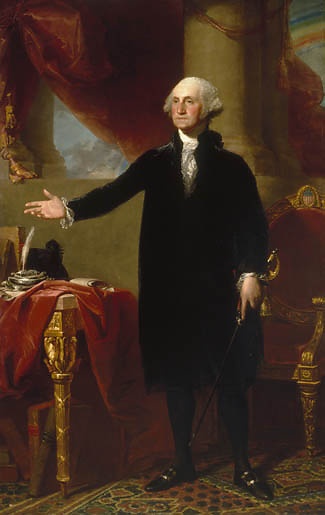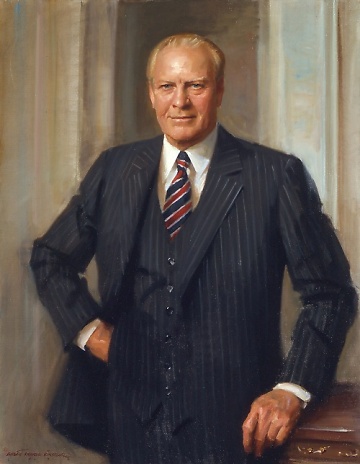A Reply To The
Wall Street Journal
Presidential Portraiture Today — Moving Beyond
Gilbert Stuart
George Washington
(The Lansdowne Portrait), 1796
By Gilbert Stuart.
Oil on canvas,
97½ x 62½ inches.
National Portrait Gallery,
Smithsonian Institution,
Washington, D.C.
|
 |
 he
writer Catesby Leigh, who muses on "Why
Presidential Portraiture Lost Its Stature"
in the Wall Street Journal (January 18, 2007,
page D7), draws a conclusion that is at odds
with, and is disconnected from, the expectations
of contemporary portrait painting. he
writer Catesby Leigh, who muses on "Why
Presidential Portraiture Lost Its Stature"
in the Wall Street Journal (January 18, 2007,
page D7), draws a conclusion that is at odds
with, and is disconnected from, the expectations
of contemporary portrait painting.
Author Leigh makes two fundamentally wrong assumptions
about portraiture: (1) that symbolism, "poetry,"
and "inspiringness" are desirable
or defining virtues in a portrait of an American
president; and (2) that realism—or naturalism—is
somehow synonymous with, and servant to, the
technology of photography.
The
portrait of President
Gerald Ford by Everett
Raymond Kinstler, which
Leigh considers "bland"
is, in fact, ten times more evocative
of a living, breathing human being
than is the theatrical, artificial
and contrived Washington by Gilbert
Stuart. |
|
|
Leigh is correct in constructing a fundamental
division, placing most portraits in one of two
broad categories: (1) those that embody symbolism
and/or "props" that are intended to
convey content and meaning, and (2) those portraits
that concentrate on the character and persona
of the subject—in other words, portraits
that present the subject as a human being rather
than a role-player. This latter category is seen
as mostly post-Sargent, and perception-based (another
correct concept).
But I would like to argue that Leigh's basic thesis
is exactly upside-down. Leigh argues that presidential
portraiture lost its stature when it turned from
the creation of paintings redolent of symbolism
and the aura of authority, and turned instead
to the up-close portrayal of the President as
an approachable and understandable human being.
President
Gerald R. Ford
By Everett Raymond Kinstler.
Oil on canvas.
National Portrait Gallery,
Smithsonian Institution,
Washington, D.C. |
 |
The two portraits selected by Leigh to illustrate
his thesis are in fact perfect to illustrate
mine, (that he has it backward). I would contend
that the "Landsdowne" George Washington,
by Gilbert Stuart, is stagey, contrived and
artificial. The subject is made to stand forever
in a theatrical or oratorical pose (which I
suspect was totally uncharacteristic of the
man) surrounded by grandiose furnishings that
serve only as allusions to history. Nothing
here, either in the setting or the pose, is
real. We are told virtually nothing about George
Washington the human being, apart from the consensus
that he was a strong and admired leader of men.
On the other hand, the portrayal of President
Ford by Everett Raymond Kinstler eschews the
well-known (by now) trappings of Presidential
power. We do not need to be reminded of Air
Force One, or seried ranks of soldiers, or long
motorcades with flashing lights, or even the
stately columns of the White House. Gerald Ford
the individual is offered to our gaze. We are
able to form an estimate of his personal warmth
(or lack thereof), his dignified mien, his potential
as a family head as well as civic magistrate—through
artist Kinstler's vividly impressionistic capture.
We are permitted to form an estimate of Gerald
Ford the man.
If both men were to suddenly walk into the room,
we would not be surprised by Ford. He would
look and act like the man we have met in the
portrait. Washington, on the other hand, would
very likely be totally unlike the remote and
unnatural figure portrayed in the Stuart painting.
The portrait of President Gerald Ford by Kinstler,
which Leigh considers "bland" is,
in fact, ten times more evocative of a living,
breathing human being than is the theatrical,
artificial and contrived Washington by
Gilbert Stuart. The Stuart Washington
is determinedly remote, statuesque and self-conscious,
while the Ford portrayal gives us a real person,
up close, devoid of pretense or pomposity. The
Ford painting is incredibly real and convincing,
while the Stuart Washington places impossible
barriers of artifice and stagecraft between
us and the subject. The viewer may study the
Stuart exhaustively and still wonder, "What
did this man look like; what type of human being
was he?" The Ford painting, on the other
hand, conveys the impression of a palpable,
authentic personality, brought right up close
for our intimate scrutiny and comprehension.
Times have changed in portraiture. Leaders—both
in politics and in business—decry any pretension
or "posing." Leaders ask to be portrayed
as "natural," "likeable,"
"approachable," etc. As a professional
portrait painter myself, I've never been asked
to work toward an Olympian or heroic result.
Just the opposite. In my own portrait practice
(now spanning some forty years and perhaps 600
sitters), subjects specifically expect to be
portrayed as down-to-earth, friendly and unpretentious.
Imagine for a moment if a painter in 2007 produced
an image of George W. Bush on a Lansdowne-sized
canvas, complete with heroic gesture and the
trappings of Roman power. The firestorm of ridicule
in the media would be breathtaking.
Writer Leigh is correct in placing John Singer
Sargent at the pivotal turning point in not
only American, but world portraiture as well,
by pointing out that Sargent's goal was the
capturing of an immediate, impressionistic appearance
of reality. The heroic aspect of Sargent's portrait
of Theodore Roosevelt is a result of the subject's
personality and instinctive inclinations, rather
than a conscious attempt by the artist to achieve
"gravitas" or inspiring stature.
Leigh's charge that today's portraitists are
slaves to their photographic reference material
has, unfortunately, some merit. In a media-drenched
society, it is increasingly difficult for today's
painters to break free of sources and give a
painted record that is totally perception-based.
But it is significant to note that today's leading
portraitists are precisely those who are making
the attempt.
It is easy to agree with author Leigh when he
posits that too much of contemporary portraiture
(and in particular, presidential portraiture)
can be bland and ordinary. One suspects that
many portraits by other artists in Gilbert Stuart's
day were ordinary, as well. But today's painters
are at least aiming at portraying their subjects
in the primarily human dimension. There probably
will not be Lansdowne-style portrait of Barack
Obama or Hillary Clinton. It is probably just
as well.
JOHN HOWARD SANDEN
New York
Click
here to read the original Wall Street
Journal article.
|